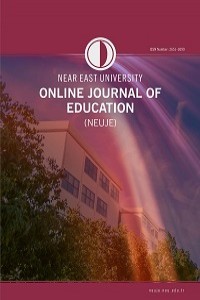THE ROLE OF FOREIGN LANGUAGE TEACHING IN ENHANCING STUDENTS’ INTERCULTURAL COMPETENCE
THE ROLE OF FOREIGN LANGUAGE TEACHING IN ENHANCING STUDENTS’ INTERCULTURAL COMPETENCE
___
- Achaeva, M., Daurova, A., Pospelova, N., & Borysov, V. (2018). Intercultural education in the system of training future teachers. Journal of Social Studies Education Research, 9(3), 261-281. Agustin, O. G. (2012). Visions of the council of Europe and the European Commission for a Post-Multiculturalist Era. Retrieved from http://mail.immi.se/intercultural/nr29/garcia.html on 27 May 2019. Arslan, H., & Raţa, G. (Eds.). (2013). Multicultural education: from Theory to Practice. US: Cambridge Scholars Publishing. Beacco, J. C., & Byram, M. (2007). From linguistic diversity to plurilingual education: Guide for the development of language education policies in Europe. Strasbourg, France: Council of Europe Publishing. Beacco, J. C., Byram, M., Cavalli, M., Coste, D., Cuenat, M. E., Goullier, F., & Panthier, J. (2016). Guide for the development and implementation of curricula for plurilingual and intercultural education. Council of Europe. Cetinavci, R. (2011). Intercultural communicative competence in English (foreign) language teaching and learning. Mediterranean Journal of Humanities, 59-71. Climent-Ferrando, V. (2016). Linguistic Neoliberalism in the European Union: Politics and Policies of the EU‟s Approach to Multilingualism. Coste, D., & Simon, D. L. (2009). The plurilingual social actor: Language, citizenship and education. International Journal of Multilingualism, 6(2), 168-185. Coste, D., Moore, D., & Zarate, G. (2009). Plurilingual and pluricultural competence. Language Policy Division. Strasbourg: Council of Europe. Council of Europe. (2001). Common European Framework of Reference for Languages: Learning, teaching, assessment. US: Cambridge University Press. Crowley, P. M. (2017). Crossing the Atlantic: Comparing the European Union and Canada. US: Routledge. Cullen, H. (1996). From migrants to citizens? European Community policy on intercultural education. International & Comparative Law Quarterly, 45(1), 109-129. Diaconescu, R., Stanciugelu, S., Copot, D., Vatavu, G., Pop, I., & Rusu, I. (2013). State and private sector involvement in developing and promoting cultural and religious heritage. European Journal of Science and Theology, 9(3), 207-217. Ebersold, S., Watkins, A., Oskarsdottir, E., & Meijer, C. J. (2019). Financing inclusive education to reduce disparity in education: Trends, issues and drivers. US: The SAGE Handbook of Inclusion and Diversity in Education. Feliu, P. G., Espona-Barcons, B., & Essomba Gelabert, M. A. (2016). How is Europe facing diversity in education? Comparing national policies on the education of children and youngsters with a migrant background. Current Politics & Economics of Europe, 27(3- 4), 375-392. Garrido, C., & Alvarez, I. (2006). Language teacher education for intercultural understanding. European Journal of Teacher Education, 29(2), 163-179. Garrido, C., & Alvarez, I. (2006). Language teacher education for intercultural understanding. European Journal of Teacher Education, 29(2), 163-179. Genova, M. (2019). Intercultural and Civic Education–Good Practices. Професионално образование, 21(2), 185-199. Giorgis, P. (2018). The spaces in between: Foreign language education as critical and intercultural education. Taboo: The Journal of Culture and Education, 17(3), 55-72. Harte, E., Herrera, F., Stepanek, M., & Rand, E. (2016). Education of EU Migrant children in EU member states. RAND. Hoffmann, W., & Briga, E. (2018). A brief overview on intercultural learning in initial teacher education and continuing professional development for teachers of upper secondary schools, intercultural learning for pupils and teachers project, funded by European commission. Retrieved from http://intercultural-learning.eu/wpcontent/ uploads/2017/01/ICL-in-ITE- on 22 June 2019. Huber, J. (2012). Intercultural competence for all: preparation for living in a heterogeneous world (Vol. 2). Council of Europe. Janta, B., & Harte, E. (2016). Education policy responses for the inclusion of migrant children in Europe. Retrieved from https://www.rand.org/pubs/research_reports/RR1655.html on 22 June 2019. Jeoffrion, C., Marcouyeux, A., Starkey-Perret, R., Narcy-Combes, M. F., & Birkan, I. (2014). From multilingualism to plurilingualism: University students‟ beliefs about language learning in a monolingual context. Language, Culture and Curriculum, 27(1), 8-26. Meer, N., & Modood, T. (2012). How does interculturalism contrast with multiculturalism?. Journal of Intercultural Studies, 33(2), 175-196. Meijer, C. J., & Watkins, A. (2019). Financing special needs and inclusive education–from Salamanca to the present. International Journal of Inclusive Education, 1-17. Mongillo, G., & Holland, K. F. (2016). Elementary teachers‟ perspectives on the use of multicultural literature in their classrooms. Language and Literacy, 18(3), 16-32. Ortega, Y. (2018). Plurilingualism in the new era: A conversation with Enrica Piccardo. Argentinian Journal of Applied Linguistics, 6(1), 75-91. Ostermark, E. (2009). Language teacher education in Finland and the cultural dimension of foreign language teaching–a student teacher perspective. European Journal of Teacher Education, 32(4), 401-421. Pop, R. (2016). Foreign language learning in today‟s multicultural and multilingual classrooms. Studia Universitatis Babes-Bolyai-Philologia, 61(3), 231-238. Pena-Díaz, C. (2019). Child language brokering: Challenges in Spanish intercultural education. Intercultural Education, 30(4), 368-382. Piccardo, E. (2017). Plurilingualism as a catalyst for creativity in superdiverse societies: A systemic analysis. Frontiers in Psychology, 8, 1-13 Sabato, S., & Vanhercke, B. (2017). Towards a European Pillar of Social Rights: From a preliminary outline to a Commission Recommendation. Social Policy in the European Union: State of the Play, 73-96. Staiger, U. (2009). New agendas? Culture and citizenship in EU policy. International Journal of Cultural Policy, 15(1), 1-16. Toggenburg, G. N. (2004). United in diversity‟: Some thoughts on the new motto of the enlarged Union. In Il Mercator International Symposium: Europe 2004: A new framework for all languages (pp. 27-28).
- ISSN: 2651-3099
- Başlangıç: 2018
- Yayıncı: Yakın Doğu Üniversitesi
THE ROLE OF FOREIGN LANGUAGE TEACHING IN ENHANCING STUDENTS’ INTERCULTURAL COMPETENCE
EXAMINATION OF TEACHERS’ OPINIONS ABOUT HOMESCHOOLING SERVICE
Özlem TOPRAK, Ahmet AHMET YIKMIŞ, Seniha KURTOĞLU
THE EUROPEAN POLICY ABOUT TRAINING STUDENTS OF LANGUAGES
EUROPEAN FOREIGN LANGUAGE TEACHING POLICY WITH THE USE OF TECHNOLOGY
Hassan Ahmed Sharif AHMED SHARİF
Secondary Education Teachers and School Administrators’ Views on Positive Organizational Climate
Yücehan YÜCESOY, Burak DEMİR, Başak BAĞLAMA, Mert BAŞTAŞ, Behçet ÖZNACAR
